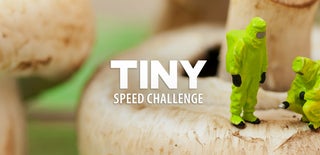Introduction: A Composition With Two Bugs
The highly respectable audience could attribute any meaning to this composition; I, as a humble artist, just explain how to make this project.
Supplies
Materials needed
an integrated circuit
1.5 …2 mm thick plastic (I used black plastic)
thin wires (0.5 mm and 0.15 mm in diameter, see text)
black paint (optional)
varnish (optional)
paper
glue
Tools needed
a jigsaw
a drill with a 1 mm diameter bit
an exacto knife
a pair wire cutters
a pair long nose pliers
a thin brush
a ruler
a pencil
Step 1: First Bug
I used an IC chip readily (which means without necessity to be desoldered out of the board) available at my shop. The dimensions of the chip are: length 9 mm, width 6 mm, overall height with legs 7 mm.
As to the second bug, it had to be manufactured. The following steps explain you the procedure.
Step 2: Body of the Second Bug
This one had to be manufactured. First, I drew a plan view of a bug as I remember it from my observations of the nature. You see in the picture a half of the view, the other half being a mirror of the first one. Then I made paper patterns of the body and the carapace.
I glued the patterns on a piece of plastic and cut the shapes with a jigsaw, then I smoothed the edges with an exact knife. I also gave rounded shape to the carapace, and made chamfers on the bottom part of the body. Three grooves to install the legs should be made in the upper part of the body as shown in the picture. A small hole should be made in the head to install the antennae. It’s optional to paint the body after the bug is assembled, if you made it of black plastic; however, you can varnish it to give it some dull finish. I painted the bug’s body with black dull gloss paint.
Step 3: Legs and Antennae
I made the legs of 0.5 mm thick copper wire; the diameter of the wire for the legs could be 0.3…0.5 mm - thick enough to hold the bug’s body. The antennae are made of 0.15 mm thick wire; in fact, I used a piece of wire from a multicore cable.
The pieces of wire are put into the grooves made in the upper part of the body, after which you fix the carapace; I used epoxy glue for this operation. The antennae are placed into the hole in the bug’s head; the length of each antenna is about 20 mm. They are fixed with a small drop of epoxy glue.
Step 4: Second Bug Ready
After the glue gets dry, you ply and cut the wires to shape them as the legs of a real bug.
Both the legs and the antennae are painted black after assembly.
The ready bug is shown in the pictures.

Participated in the
Tiny Speed Challenge











